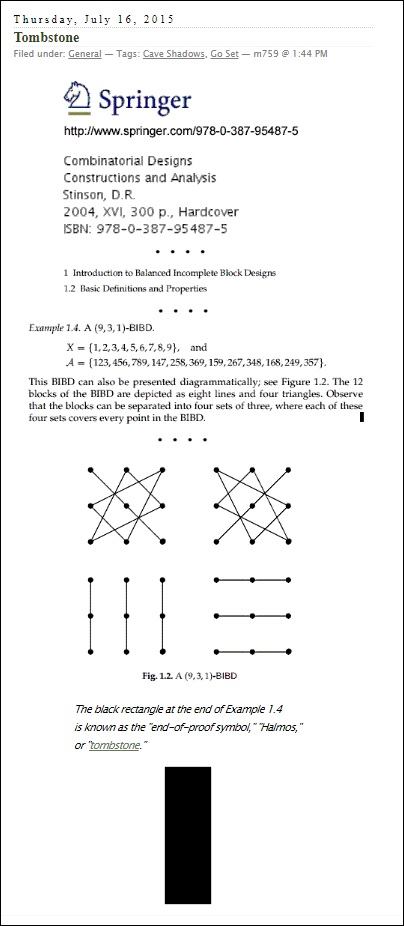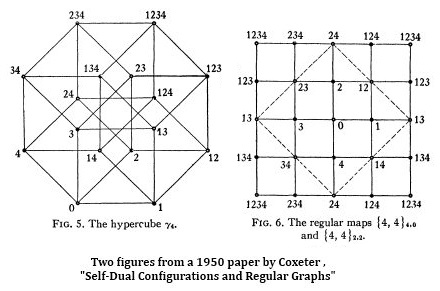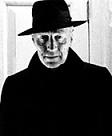Some nine-dot patterns of greater interest:
Sunday, May 26, 2019
Nine-Dot Patterns
Monday, March 12, 2018
“Quantum Tesseract Theorem?”
Remarks related to a recent film and a not-so-recent film.
For some historical background, see Dirac and Geometry in this journal.

Also (as Thas mentions) after Saniga and Planat —
The Saniga-Planat paper was submitted on December 21, 2006.
Excerpts from this journal on that date —
"Open the pod bay doors, HAL."
Monday, June 12, 2017
Bubble
The "bubble" passage in the previous post suggests a review of
a post from December 21, 2006, with the following images —


Update of 11:01 PM ET the same day, June 12, 2017 —
Related material for the Church of Synchronology —
From a tech-article series that began on Halloween 2006 and
ended on the date of the above Geometry's Tombstones post —



Compare and contrast (from a post of Feb. 27, 2017) —
“Lord Arglay had a suspicion that the Stone would be
purely logical. Yes, he thought, but what, in that sense,
were the rules of its pure logic?”
—Many Dimensions (1931), by Charles Williams
See also "The Geometry of Logic:
Finite Geometry and the 16 Boolean Connectives"
by Steven H. Cullinane in 2007.
Friday, March 17, 2017
Narrative for Westworld
“That corpse you planted
last year in your garden,
Has it begun to sprout?
Will it bloom this year?
Or has the sudden frost
disturbed its bed?”
— T. S. Eliot, “The Waste Land“
Click the book for a video.
Thursday, March 7, 2013
Proof Symbol
Today's previous post recalled a post
from ten years before yesterday's date.
The subject of that post was the
Galois tesseract.
Here is a post from ten years before
today's date.
The subject of that post is the Halmos
tombstone:
"The symbol ![]() is used throughout the entire book
is used throughout the entire book
in place of such phrases as 'Q.E.D.' or 'This
completes the proof of the theorem' to signal
the end of a proof."
— Measure Theory (1950)
For exact proportions, click on the tombstone.
For some classic mathematics related
to the proportions, see September 2003.
Thursday, August 16, 2012
Raiders of the Lost Tesseract
(Continued from August 13. See also Coxeter Graveyard.)
Here the tombstone says
"GEOMETRY… 600 BC — 1900 AD… R.I.P."
In the geometry of Plato illustrated below,
"the figure of eight [square] feet" is not , at this point
in the dialogue, the diamond in Jowett's picture.
An 1892 figure by Jowett illustrating Plato's Meno—
Jowett's picture is nonetheless of interest for
its resemblance to a figure drawn some decades later
by the Toronto geometer H. S. M. Coxeter.
A similar 1950 figure by Coxeter illustrating a tesseract—
For a less scholarly, but equally confusing, view of the number 8,
see The Eight , a novel by Katherine Neville.
Thursday, October 20, 2011
The Thing Itself
Suggested by an Oct. 18 piece in the Book Bench section
of the online New Yorker magazine—
Related material suggested by the "Shouts and Murmurs" piece
in The New Yorker , issue dated Oct. 24, 2011—
"a series of e-mails from a preschool teacher planning to celebrate
the Day of the Dead instead of Halloween…"
A search for Coxeter + Graveyard in this journal yields…
Here the tombstone says "GEOMETRY… 600 BC — 1900 AD… R.I.P."
A related search for Plato + Tombstone yields an image from July 6, 2007…

Here Plato's poems to Aster suggested
the "Star and Diamond" tombstone.
The eight-rayed star is an ancient symbol of Venus
and the diamond is from Plato's Meno .
The star and diamond are combined in a figure from
12 AM on September 6th, 2011—
The Diamond Star

See Configurations and Squares.
That webpage explains how Coxeter
united the diamond and the star.
Those who prefer narrative to mathematics may consult
a definition of the Spanish word lucero from March 28, 2003.
Monday, November 29, 2010
Philosopher’s Stone
Happy Ending
Part I —
Plato's
Tombstone
Part II —
Star and Diamond
United

(See previous post and
a note on design.)
Monday, June 16, 2008
Monday June 16, 2008
(American Mathematical Society Feb. 2008
review of Steven Brams’s Superior Beings:
If They Exist, How Would We Know?)
(pdf, 15 megabytes)
"Brams does not attempt to prove or disprove God. He uses elementary ideas from game theory to create situations between a Person (P) and God (Supreme Being, SB) and discusses how each reacts to the other in these model scenarios….
1) P can believe in SB's existence
2) P can not believe in SB's existence
The Supreme Being also has two options:
1) SB can reveal Himself
2) SB can not reveal Himself
Each player also has a primary and secondary goal. For the Person, the primary goal is to have his belief (or non-belief) confirmed by evidence (or lack thereof). The secondary goal is to 'prefer to believe in SB’s existence.' For the Supreme Being, the primary goal is to have P believe in His existence, while the secondary goal is to not reveal Himself. These goals allow us to rank all the outcomes for each player from best (4) to worst (1). We end up with a matrix as follows (the first number in the parentheses represents the SB's ranking for that box; the second number represents P's ranking):

Analogously:
|
Lotteries on Bloomsday, June 16, 2008 |
Pennsylvania (No revelation) |
New York (Revelation) |
|
Mid-day (No belief) |
418
No belief, |
064
Revelation |
|
Evening (Belief) |
709
Belief without |
198
|
The holy image

denoting belief and revelation
may be interpreted as
a black hole or as a
symbol by James Joyce:
|
When? Going to dark bed there was a square round Sinbad the Sailor roc's auk's egg in the night of the bed of all the auks of the rocs of Darkinbad the Brightdayler. Where?
— Ulysses, conclusion of Chapter 17 |
Sunday, May 18, 2008
Sunday May 18, 2008
From the Grave
in yesterday's New York Times:
"From the grave, Albert Einstein
poured gasoline on the culture wars
between science and religion this week…."
An announcement of a
colloquium at Princeton:
Above: a cartoon,
"Coxeter exhuming Geometry,"
with the latter's tombstone inscribed
"GEOMETRY
600 B.C. —
1900 A.D.
R.I.P."

The above is from
The Paradise of Childhood,
a work first published in 1869.
"I need a photo-opportunity,
I want a shot at redemption.
Don't want to end up a cartoon
In a cartoon graveyard."
— Paul Simon

Albert Einstein,
1879-1955:
"It is quite clear to me that the religious paradise of youth, which was thus lost, was a first attempt to free myself from the chains of the 'merely-personal,' from an existence which is dominated by wishes, hopes and primitive feelings. Out yonder there was this huge world, which exists independently of us human beings and which stands before us like a great, eternal riddle, at least partially accessible to our inspection and thinking. The contemplation of this world beckoned like a liberation…."
— Autobiographical Notes, 1949
Related material:
A commentary on Tom Wolfe's
"Sorry, but Your Soul Just Died"–
"The Neural Buddhists," by David Brooks,
in the May 13 New York Times:
"The mind seems to have
the ability to transcend itself
and merge with a larger
presence that feels more real."
A New Yorker commentary on
a new translation of the Psalms:
"Suddenly, in a world without
Heaven, Hell, the soul, and
eternal salvation or redemption,
the theological stakes seem
more local and temporal:
'So teach us to number our days.'"
and a May 13 Log24 commentary
on Thomas Wolfe's
"Only the Dead Know Brooklyn"–
"… all good things — trout as well as
eternal salvation — come by grace
and grace comes by art
and art does not come easy."
"Art isn't easy."
— Stephen Sondheim,
quoted in
Solomon's Cube.
For further religious remarks,
consult Indiana Jones and the
Kingdom of the Crystal Skull
and The Librarian:
Return to King Solomon's Mines.
Friday, July 6, 2007
Friday July 6, 2007
of Good and Evil
continued from
Midsummer Night…
— Glenna Whitley, “Voodoo Justice,”
The New York Times, March 20, 1994

In Other Game News:
“Coxeter Exhuming Geometry”
suggests the following
illustration, based
in part on
Plato’s poem to Aster:

Related material:
and
The proportions of
the above rectangle
may suggest to some
a coffin; they are
meant to suggest
a monolith.
Saturday, December 16, 2006
Saturday December 16, 2006

— From Pedagogy, Praxis, Ulysses
A quotation omitted from the above excerpt:
In Ulysses, there is "… the same quality of simultaneity as in cubist collage. Thus, for example, Bloom surveys the tombstones at Paddy Dignam's funeral and, in the midst of platitudinous and humorous thoughts, remembers Molly 'wanting to do it at the window'…."
Related material from quotations at the poetry journal eratio:
"The guiding law of the great variations in painting is one of disturbing simplicity. First things are painted; then, sensations; finally, ideas. This means that in the beginning the artist's attention was fixed on external reality; then, on the subjective; finally, on the intrasubjective. These three stages are three points on a straight line."
— Jose Ortega y Gasset ("On Point of View in the Arts," an essay on the development of cubism)
Related material on
tombstones and windows:
Geometry's Tombstones,
Galois's Window, and
Architecture of Eternity.

See also the following part
of the eratio quotations:

Quotations arranged by
Gregory Vincent St. Thomasino
Thursday, December 14, 2006
Thursday December 14, 2006
Thursday, November 16, 2006
Thursday November 16, 2006
Dante, Inf., canto X.
Words
for
G. Robert Crowningshield,
a developer of the
International Diamond
Grading System™
According to a
press release,
Crowningshield
died on
November 8.
See Grave Matters,
an entry of that date,
and its links to
Geometry’s Tombstones,
Birth, Death, and Symmetry,
and
Religious Symbolism
at Princeton.
| Dante, Inferno, Canto X, 37-39:
E l’animose man del duca e pronte And the bold and ready hands “Make your words count,” |
Perhaps Crowningshield’s
Leader will be…

Niemoller is noted for his role in
the movement that led to the
Barmen Declaration, discussed in
Presbyterian Creedal Standards—
linked to in the above-cited
Religious Symbolism
at Princeton
(…that lay in the house
that Jack built).

Wednesday, November 8, 2006
Wednesday November 8, 2006
See Log24 four years ago
on this date:
Religious Symbolism
at Princeton.
Compare and contrast
with last month’s entries
related to a Princeton
Coxeter colloquium:
Thursday, October 19, 2006
Thursday October 19, 2006
(continued from Sept. 5):

Thanks to Peter Woit’s weblog
for a link to the above illustration.
This picture of
“Coxeter Exhuming Geometry”
suggests the following comparison:

For the second tombstone,
see this morning’s entry,
Birth, Death, and Symmetry.
Further details on the geometry
underlying the second tombstone:

The above is from
Variable Resolution 4–k Meshes:
Concepts and Applications (pdf),
by Luiz Velho and Jonas Gomes.
See also Symmetry Framed
and The Garden of Cyrus.
| “That corpse you planted last year in your garden, Has it begun to sprout? Will it bloom this year? Or has the sudden frost disturbed its bed?” — T. S. Eliot, “The Waste Land“ |
Thursday, October 5, 2006
Thursday October 5, 2006
(Title of an interview with
the late Paul Halmos, mathematician)
From a 1990 interview:
“What’s the best part of being a mathematician? I’m not a religious man, but it’s almost like being in touch with God when you’re thinking about mathematics. God is keeping secrets from us, and it’s fun to try to learn some of the secrets.”
I personally prefer Annie Dillard on God:
“… if Holy the Firm is matter at its dullest, Aristotle’s materia prima, absolute zero, and since Holy the Firm is in touch with the Absolute at base, then the circle is unbroken. And it is…. Holy the Firm is in short the philosopher’s stone.”
Some other versions of
the philosopher’s stone:
April 28, 2004:

This last has the virtue of
being connected with Halmos
via his remarks during the
“In Touch with God” interview:
“Combinatorics, the finite case, is where the genuine, deep insight is.”
See also the remark of Halmos that serves as an epigraph to Theme and Variations.
the 4×9 black rectangle

has also served
at least one interpreter
as a philosopher’s stone,
and is also the original
“Halmos tombstone.”
Sunday, March 9, 2003
Sunday March 9, 2003
Symbols —
Broadway:
The Sound of Silence
|
Hello darkness, my old friend. I’ve come to talk with you again. (See previous entry, Mar. 7, “Lovely, Dark and Deep.) |
And the people bowed and prayed to the neon god they made. (See CNN.com Broadway City Arcade club story of Mar. 9) |
The words of the prophets are written on the subway walls. (See picture in NY Times Book Review, Mar. 9, page 31.) |
See also the footnote on the Halmos “tombstone” symbol in the previous entry, the entry “Dustin in Wonderland” of Feb. 24, the film “Marathon Man,” and the entry “Geometry for Jews” of March 6.




















